the constant inequality of leonor’s days*
Exhibition
From 6 June to 31 August
Curator: Leonor Antunes, Marie Cozette and Rita Fabiana
Press preview Thursday 5 June.
Opening Friday 6 June.
Concert - event : OCCAM XXVII and OCCAM RIVER XVI by Éliane Radigue Saturday 7 June.
The exhibition was conceived and produced by the CAM - Centro de Arte Moderna Gulbenkian in Lisbon, and curated by Rita Fabiana. It received support from the French delegation of the Gulbenkian Foundation.
the constant inequality of leonor’s days* is presented following the exhibition da desigualdade constante dos dias de leonor*, presented at the CAM from 21 September 2024 to 17 February 2025.
the constant inequality of leonor’s days* is a new sculptural installation by Leonor Antunes (born in 1972 in Lisbon), spread across six rooms on the ground floor of the Crac Occitanie. For over twenty-five years, Leonor Antunes has been developing a body of work made up of sculptural suspensions that inhabit architectures, while offering a critical interpretation of the sites and their histories. At the Crac, visitors are invited to freely roam a forest of objects that combine the language of sculpture with those of decorative arts, costumes, and stage furniture, decompartmentalising the conventional categories of art, design, and architecture.
the constant inequality of leonor’s days* is a readaptation of the exhibition presented in Lisbon. The title is followed by an asterisk indicating that it is a citation. Leonor Antunes borrows this title from a drawing by Portuguese artist, filmmaker, writer and poet Ana Hatherly (1929–2015). It contains Leonor Antunes’s first name, and the drawing was created in 1972, the year she was born, a biographical coincidence that reinforces her deep private connection with Hatherly. The latter’s drawing is a tangle of words, its density making the text almost unreadable. This becomes material for a relationship with language that is radically poetic and in motion. In Lisbon, alongside the installation of her works, Leonor Antunes curated an exhibition that she assembled from the CAM’s collection, presenting a selection of works dedicated exclusively to women artists, some of whose pieces were shown for the first time since their acquisition.
the constant inequality of leonor’s days* drew inspiration from the CAM’s architecture. Opened in 1983, the building was designed by British architect
Leslie Martin. Although his wife and collaborator Sadie Speight (1906 - 1996) contributed to the project, her name remained in the shadows. Yet she is a central figure of the UK’s modernist movement, as a forerunner in the critique of contemporary design in the 1940s. Architect, Sadie Speight also conceived design objects like rugs and tapestries, particularly in the context of architectural projects. According to Leonor Antunes: “Sadie Speight’s work, which had a strong presence in the CAM project, never got the recognition it deserved”.
The research that Leonor Antunes conducted for her exhibition at the CAM enabled her to rediscover marginalised figures from the history of art and design.

Vue de l’exposition "da desigualdade constante dos dias de leonor*" de Leonor Antunes, 2024-2025, Centre d’Art Moderne de la Fondation Gulbenkian, Lisbonne. "Franca e Sophie #4" (détail), 2024, perles de verre, fil de nylon, fil FireLine, acier inoxydable enduit de poudre, c. 340 x 130 cm. Courtesy de l’artiste. Photo : Nick Ash, 2024.
Exhibiting Artist
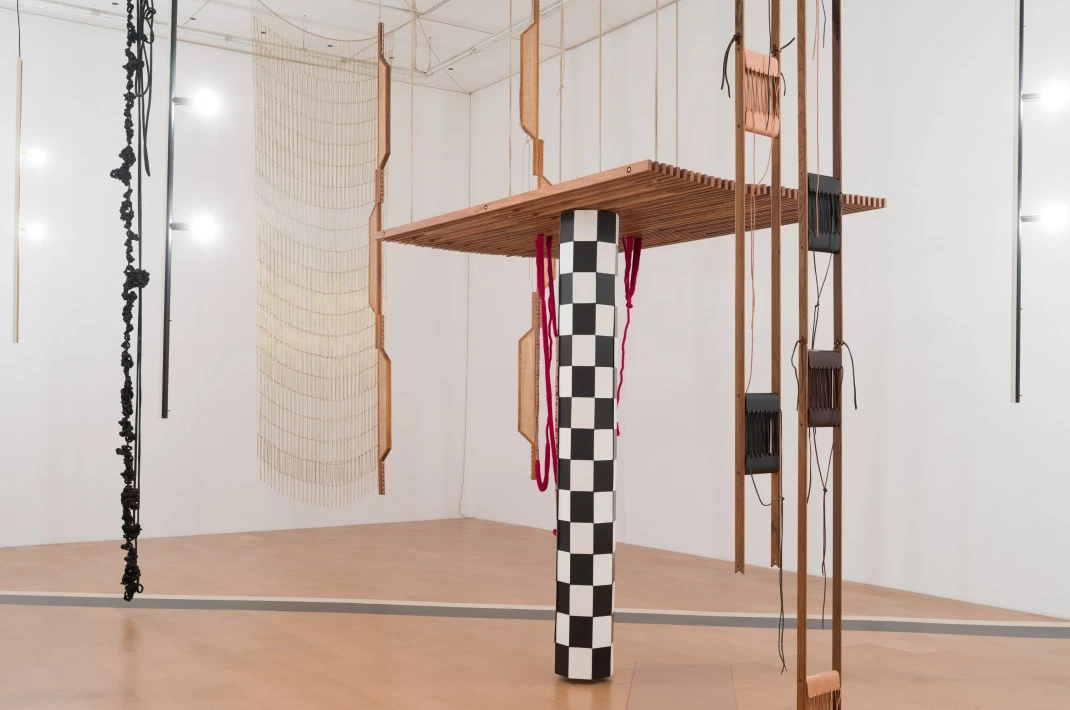
Vue de l’exposition « les inégalités constantes des jours de leonor* » de Leonor Antunes, 2025, Crac Occitanie, Sète. Photo : Nick Ash.
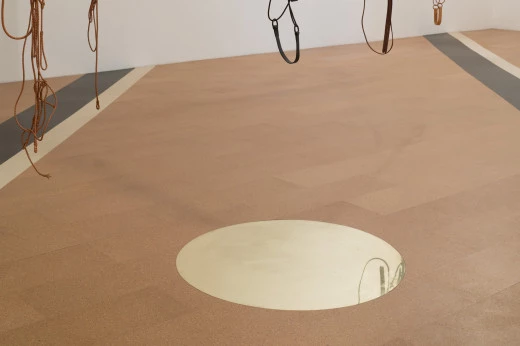
Vue de l’exposition « les inégalités constantes des jours de leonor* » de Leonor Antunes, 2025, Crac Occitanie, Sète. Photo : Nick Ash.
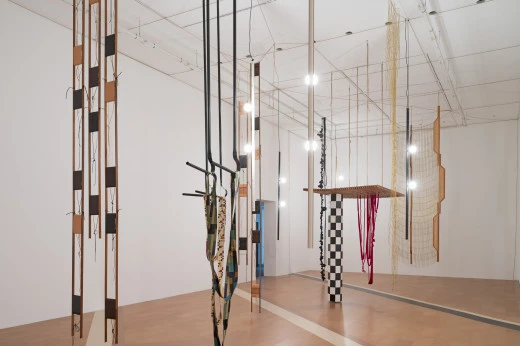
Vue de l’exposition « les inégalités constantes des jours de leonor* » de Leonor Antunes, 2025, Crac Occitanie, Sète. Photo : Nick Ash.
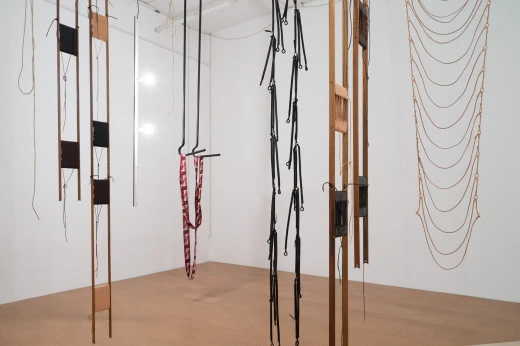
Vue de l’exposition « les inégalités constantes des jours de leonor* » de Leonor Antunes, 2025, Crac Occitanie, Sète. Photo : Nick Ash.
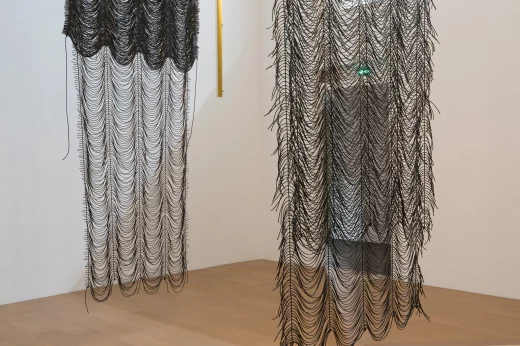
Vue de l’exposition « les inégalités constantes des jours de leonor* » de Leonor Antunes, 2025, Crac Occitanie, Sète. De gauche à droite, « Franco II » et « Franco I », 2017, cuir. Courtesy de l’artiste et galerie kurimanzutto Mexico/New York, États-Unis. Au centre, « discrepâncias com M.P. », 2024, aluminium thermolaqué, câbles électriques, laiton, câbles en acier inoxydable et ampoules électriques. Courtesy de l’artiste. Au sol, « forty five », 2024, liège, linoleum, cuivre. Courtesy de l’artiste. Photo : Nick Ash.
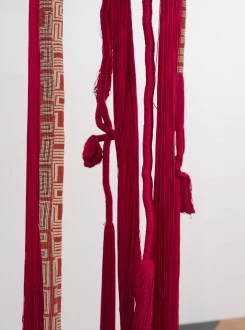
Vue de l’exposition « les inégalités constantes des jours de leonor* » de Leonor Antunes, 2025, Crac Occitanie, Sète. « Sadie », 2024, soie, perles de verre, fil nylon. Courtesy de l’artiste. Photo : Nick Ash.
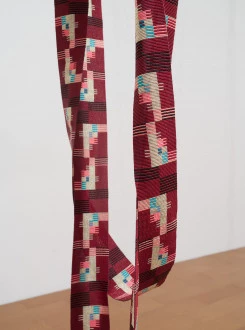
Vue de l’exposition « les inégalités constantes des jours de leonor* » de Leonor Antunes, 2025, Crac Occitanie, Sète. « Franca e Sophie #1 », 2024, perles de verre, fil en nylon et acier inoxydable thermolaqué. Courtesy de l’artiste. Photo : Nick Ash.
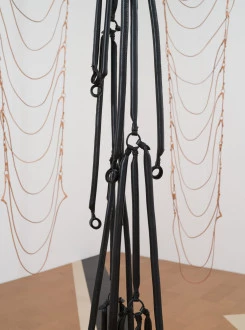
Vue de l’exposition « les inégalités constantes des jours de leonor* » de Leonor Antunes, 2025, Crac Occitanie, Sète. Au premier plan, « Ana #3 », 2024, cuir, corde de coton et fil de nylon. Au second plan, « discrepancies with S.S. #1 », 2024, cuir et fil de nylon. Au sol, « forty five », 2024, liège, linoleum, cuivre. Courtesy de l’artiste. Photo : Nick Ash.
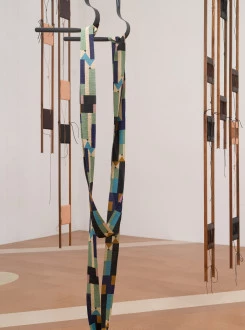 + 23 autres photos
+ 23 autres photos
Vue de l’exposition « les inégalités constantes des jours de leonor* » de Leonor Antunes, 2025, Crac Occitanie, Sète. Au premier plan, de gauche à droite, « Franca e Sophie #3 », 2024, perles de verre, fil en nylon et acier inoxydable thermolaqué ; « Franca e Sophie #4 », 2024, perles de verre, fil en nylon et acier inoxydable thermolaqué. Au second plan, « nuages », 2024, cuir, bois de teck, bois de noyer et corde de chanvre. Au sol, « forty five », 2024, liège, linoleum, cuivre. Courtesy de l’artiste. Photo : Nick Ash.
Téléchargements
- Téléchargez : Press kit - Exhibition "les inégalités constantes des jours de leonor*" by Leonor Antunes
- Téléchargez : Dossier de presse de l’exposition "les inégalités constantes des jours de leonor*" de Leonor Antunes
- Téléchargez : Guide de visite de l’exposition "les inégalités constantes des jours de leonor*" de Leonor Antunes



































































